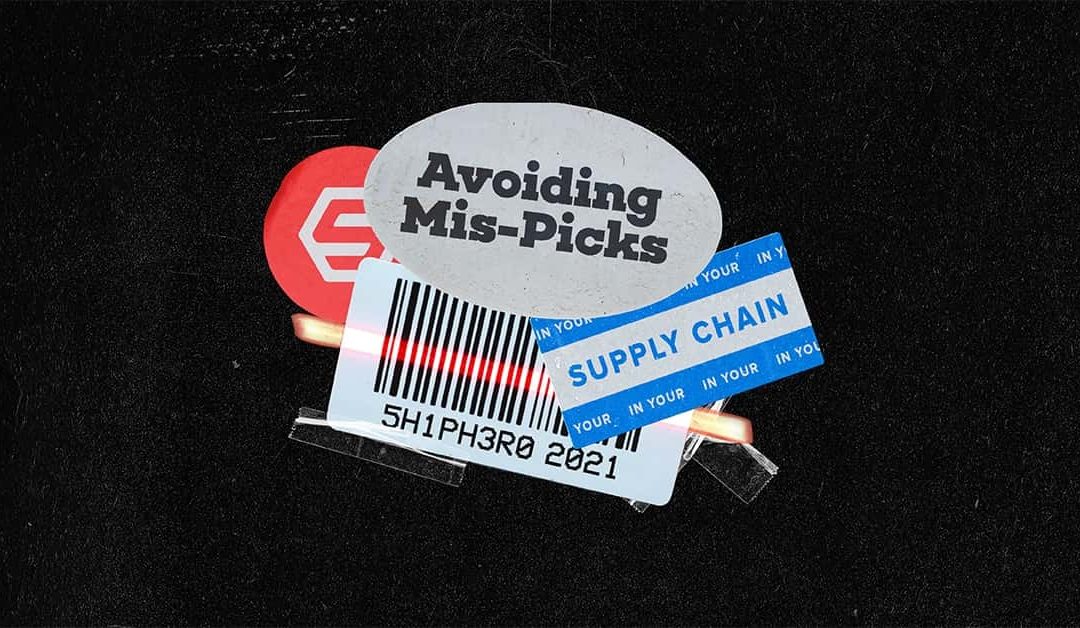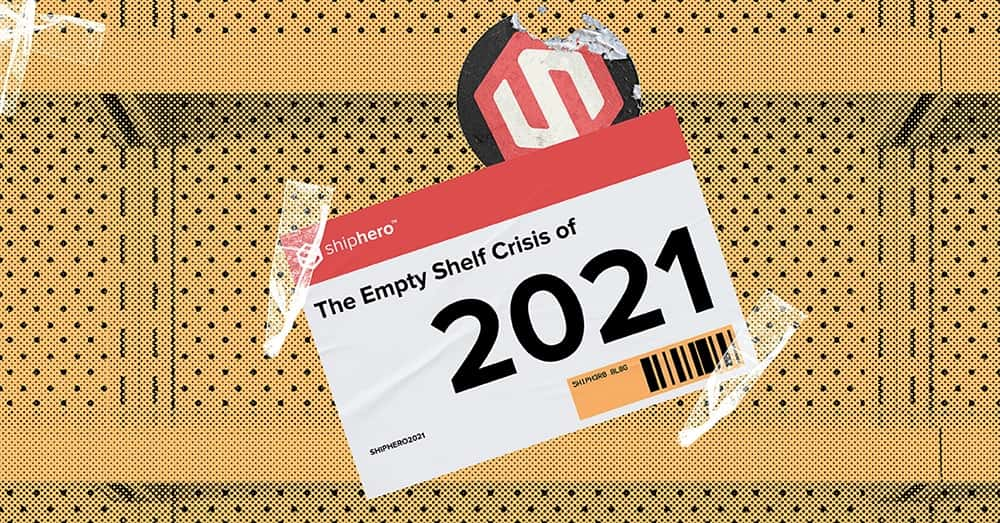
Jun 30, 2021 | Best Practices, Blog, Fulfillment, Warehouse Operations
By: Aaron Rubin, Founder & CEO at ShipHero
Mis-picks in your company’s order fulfillment process: frivolous mistakes or detrimental problems on your warehouse floor? Well, considering that distribution centers lose an average of almost $585,000 a year because of mis-picks, it may not just be a harmless error after all.
To help your organization spot and fix errors in your pick-pack process, we’ll list the most common errors that lead to mis-picks, and give you solutions to avoid mis-picks in your warehouse.
What is the Pick-Pack Process?
The pick-pack process is defined as the process of collecting, or picking, ordered items from the inventory, and then packing these items for shipment to customers.
Warehouses are a busy place, with employees meandering from bin to bin and picking items, all while heavy machines move products to the right place at the right time. Of course, mistakes are bound to happen in such a hectic work environment, with an estimated 35% of facilities experiencing constant mis-pick rates of about 1% or more.
But any extra, unnecessary movement by an employee, in the case of a mis-pick, can jeopardize the flow of your whole operation and cost your business in the long run. The cost of the mis-pick (on average) is about $30 per incident.
If you want to increase your order fulfillment rate, accurately and efficiently picking ordered items is vital. An error at this first step can have detrimental downstream effects, cause shipping delays, and increase your shipping costs. Here are some common mistakes.
Common Mistakes in the Pick-Pack Process
Among all the possible mistakes in the end-to-end order fulfillment process, picking mistakes happen to be the most common. As a result, distribution centers lose an average of almost $390,000 a year due to mis-picks.
The severity of these errors can vary for your organization; for example, while an incorrectly picked item could be more detrimental to your customer’s trust, a mistaken additional item shipped along with the correct item impacts your margins.
Mis-picks are usually a result of minor errors made by warehouse workers, whether it’s from poor lighting, fatigue, or miscommunication. Here are some of the most common mistakes to avoid.
Picking the Incorrect Item from the Correct Location
In this scenario, the picker heads to the correct bin and grabs the item inside, but it’s not the correct item. This occurs due to a problem with the inventory replenishment process. As a result, the picker will have to find the correct item from somewhere else.
Substituting Incorrect Items
If your business is experiencing stock-outs of certain items, pickers may be unsure what to do when they cannot locate the exact item. Similarly, a picker may accidentally pick the wrong item due to unclear instructions or products that look the same.
Adding Incorrect Items
In the case of bulk orders, your picker might accidentally throw in one product too many, or maybe one wrong item altogether. While the customer might be enthused, this has the potential to impact your margins and inventory levels over time.
How to Fix Picking Mistakes
The scenarios above typically occur when warehouses are using a paper-based, pick-pack process, where pickers follow orders written/printed on physical paper. Some organizations are vastly reducing their error-rate by moving to a mobile device-based system.
Here are some ways to reduce these mistakes and keep your company warehousing running efficiently and smoothly.
Measurement is the First Step
To accurately understand the situation and measure any progress, you should start collecting the necessary data.
Set up KPIs (i.e., key performance indicators) to measure picking accuracy. We recommend setting the following KPIs to get the full picture on your order fulfillment capabilities.
Order Fulfillment and Accuracy
No one likes to receive an order that isn’t theirs. This KPI lets you know how many packages you’ve shipped that have successfully arrived at the appropriate destination. If the order fulfillment values start to dip, then you’ll need to consider the influence it can have on customer opinions about your business.
Order accuracy data will also let you know whether your 3PL delivery line needs to be improved. If you’re sitting on an unusually low percentage of accurate orders, then there may be line errors at your warehouse that you need to address.
Inventory Levels
Whether you have invested in warehousing solutions or store your own inventory, you need to know where your inventory levels stand on a day-to-day basis. Rely on inventory level KPIs to replenish your stock when necessary and to calculate your business’s average supply-to-demand ratio.
Order Volume
If you’re manufacturing products several months in advance, you need to know how much of your inventory goes out per month on average. Order volume KPIs calculate your sales by day, month, or quarter, depending on your needs. You can use year-out estimates to track the ebb and flow of your sales and to pre-produce inventory for each month.
Be sure to communicate your order fulfillment goals and progress, and reward your staff for any improvements made in certain fields.
Label Boxes Correctly
While this may sound like common sense, mislabeling boxes is a common mistake. Properly identifying and labeling items will help lower the risk of picking the wrong items.
With barcode scanning technology, your pickers can scan items into locations and optimally place the necessary signs, rack labels, and aisle markers to help pickers easily and quickly identify storage locations.
Use Collaborative Mobile Robots
Tired employees make more mistakes, so keeping them alert and rested is crucial to lowering picking mistakes. Collaborative mobile robots can help improve pick rates simply by reducing the need for your workers to walk unnecessarily.
Mobile robots can also help keep employees on task by effectively leading them to choose locations through optimized routes, as well as displaying ordered items and the quantities to pick.
Move From Paper-Based to Mobile-Based
Paper-based operations, while inexpensive and easy to set up, leave your company vulnerable to errors, product loss, and reduced order fulfillment rates.
That’s why more and more companies are transitioning to mobile-based processes. With small investments in mobile devices and the right warehouse management software, your organization unlocks the potential for warehouse staff to independently organize their pick/pack tasks, as well as scan products and bins at each step to minimize human error with built-in redundancies to double-check and triple-check their items.
Additionally, a software solution like ShipHero can directly integrate with e-commerce stores on Shopify, BigCommerce and more, so order information can be distributed right to the picking staff. Also, you can also monitor inventory levels in real-time and coordinate replenishment right when you run out.
Wrap It Up
Picking errors have the potential to drastically impact order fulfillment operations, leading to shipping delays, damaging your reputation, and hurting your bottom line. Developing a reliable and accurate pick, pack, and shipping process is vital to scaling your business, so consider investing in mobile-based picking processes, as well as the right software to drastically increase your order fulfillment rate.
That’s why more and more companies trust ShipHero WMS. Pick-packers can scan products at each step of the process with everyday mobile devices.
Schedule a meeting today with our experts to learn more about our WMS software built for ecommerce brands & 3PLs looking to run their best warehouse and how ShipHero works to ensure that organizations invest in the solutions that match their needs, to improve productivity, revenue, and success.
Click HERE to Schedule a Meeting Today
Aaron Rubin, Founder & CEO
ShipHero
About the author: Aaron Rubin the Founder & CEO of ShipHero. He is responsible for planning and executing the overall vision and strategy of the organization. Rubin’s greatest strengths are leadership, change management, strategic planning and a passion for progression. He is known for having his finger on the pulse of ShipHero’s major initiatives, his entrepreneurial spirit, and keen business acumen. His leadership of ShipHero is grounded in providing excellent customer service that drives improved business operations. His passion for ShipHero comes from the culture and his ability to have an impact on the lives of employees, customers, partners, and investors.
Follow Aaron on Twitter & LinkedIn.

Jun 23, 2021 | newsroom
Riverwood Capital invests in ShipHero to accelerate its product roadmap and consolidate its leadership in helping brands and mid-large merchants with their ecommerce shipping and fulfillment needs
New York, New York – June 23rd, 2021 – ShipHero, the leading e-commerce fulfillment technology and outsourced fulfillment provider, announces today the close of a $50 million round led by high-growth tech investor Riverwood Capital. ShipHero provides a best-in-class warehouse management software-as-a-service platform for companies that want to ship from their own facilities, as well as a next generation outsourced fulfilment service to DTC brands and merchants utilizing ShipHero’s owned and operated facilities. The business ships out of three warehouses strategically located across the US; that number is expected to grow to ten by the end of 2021.
ShipHero serves more than 5,000 mid-to-large brands and merchants, including several Fortune 500 customers, and focuses on providing the most efficient and tech-driven solution for its customers to scale their ecommerce operations while delivering a superior shipping and digital experience to their consumers.
This primary investment represents ShipHero’s first institutional funding. CEO and Founder Aaron Rubin and his team bootstrapped ShipHero into a leading platform, building a SaaS solution for warehouse management and a highly-efficient and scalable outsourced fulfillment offering. The company now processes over $5 billion of ecommerce gross merchandise volume (GMV) annually, which is more than Shopify at the time of its IPO. In 2020 alone, ShipHero tripled its revenue as the company led the industry in logistics and fulfillment amid growing demand on ecommerce customers.
Prior to the investment from Riverwood, ShipHero had avoided taking venture capital or strategic funding. “We have always been focused on long-term impact and on building a solid software-driven and high-quality foundation, and for years staying independent gave us the most flexibility in how we achieve that impact,” says Aaron Rubin, CEO and Founder of ShipHero. “Our market opportunity has expanded significantly, and we have a great opportunity to accelerate our offering to clients as they digitize their businesses. The industry has raised a lot of capital recently and we were approached by high quality investors. Riverwood has a sterling reputation for allowing companies to grow in their own way and has invaluable experience with taking companies public, both of which were very important for us.”
ShipHero has built its company with a customer-first approach, continuously rolling out new technology to meet the increasing demands of the ecommerce landscape and is the leading provider of warehouse management solutions and outsourced fulfillment services to Shopify brands as a Shopify Plus partner.
ShipHero is loved by its customers with exceptional online reviews and user ratings that are significantly higher than its competitors. “It’s been incredible watching ShipHero grow into the company we are today,” adds Maggie Barnett, COO of ShipHero. “We are entering into an exciting phase with Riverwood Capital and look forward to further expanding our capabilities as the category leader in ecommerce logistics and fulfillment.”
“Demand for warehouse management and fulfillment solutions are growing at a significant pace driven by continued online and ecommerce adoption, which was only further accelerated by COVID-related lockdowns,” said Francisco Alvarez-Demalde, Co-Founder and Managing Partner at Riverwood Capital. “Brands, retailers, and merchants need to constantly improve their service and digital experience which mandates a trusted technology and fulfillment partner to ship quickly and efficiently. ShipHero has built an incredible leading platform, combining scalable and flexible software with world class and efficient operations which can ultimately help brands scale ecommerce operations while delivering the best customer service.”
“When we first met Aaron, Maggie and the team, we were drawn to their thoughtful, grounded approach to building a high-growth business,” said Joe De Pinho, Principal at Riverwood Capital. “ShipHero punches far above its weight, offering a better solution and winning market share from well-funded competitors. With a Rule of 40 metric in excess of 150%, CAC payback of a few months, a category leading software platform, and strong referrals in place from happy customers, ShipHero has reached its current growth stage and over 200 employees with only $500k in external funding. At ShipHero, the focus has always been about delivering customer satisfaction while building with scalability in mind and we are excited to support their mission to empower e-commerce merchants.”
About ShipHero
ShipHero is a US based, leading provider of cloud-based e-commerce fulfillment solutions for mid-large shippers. With more than 5,000 customers located around the globe, ShipHero offers online retailers a suite of services ranging from warehouse management software to outsourced fulfillment as a service. Some notable customers include Universal Music Group and Canadian Tire.
About Riverwood
Riverwood Capital invests in high-growth companies in the technology and technology-enabled industries. Riverwood offers a unique combination of operational, strategic, technology, and financial insight to portfolio companies that typically need growth capital and expertise to scale on a global basis. The firm seeks to invest in established businesses with a proven technology and business model, and the proper fit in terms of culture and values. Riverwood has offices in Menlo Park, CA; New York, NY; and São Paulo, Brazil. For more information, please visit www.riverwoodcapital.com
Media Inquires: media@shiphero.com

Jun 21, 2021 | 3PL Warehouse Management, Blog, Fulfillment, Warehouse Management Software
In the subtle words of The New York Times headline, “Chaos Strikes Global Shipping”. What does it mean by that exactly?
Swing by your local department store, grocery store or electronics store, and you’re bound to notice empty shelves. Previously, people blamed COVID-19 panic buyers for emptying store shelves because they stripped stores clean of essentials like toilet paper and water bottles. However, the current empty shelf crisis comes from suppliers that can’t keep up with demand due to lower production, shipping delays and labor shortages.
As a result, consumers are seeing widespread shortages of goods, from shoes to cars and everything in between. In this post, we’ll take a closer look at the empty shelf crisis, the industries that are impacted the most and what the future may hold for the shipping industry.
Why Are Walmart Shelves Empty?
There are many empty Walmart shelves in 2022 because of the Omicron variant, winter storms and supply chain problems. Here’s a quick dive into each of those reasons:
The Omicron Variant
The Omicron variant of COVID-19 was discovered in November 2021 and caused a new American COVID wave in early 2022. Many Walmart stores temporarily closed for deep cleaning due to rising cases, which meant people had fewer stores to shop at – ultimately resulting in empty shelves across many locations.
Winter Storms
Mid-January 2022 saw a winter storm plague much of the Southern, Mid-Atlantic and Northeastern United States. Heavy snowfall and blocked roads caused food shortages in affected areas, resulting in low stocks almost everywhere.
Supply Chain Crisis
Unfortunately, some lingering supply chain issues in 2021 carried over to 2022. Many stores have resorted to importing extra grocery items on chartered cargo ships to ease these shortages.
What Caused the Empty Shelf Crisis?
The empty shelf crisis is largely caused by the COVID-19 pandemic destabilizing the entire shipping industry. There’s some irony to this shipping crisis because, while consumer demand and spending increased, suppliers couldn’t keep shelves stocked to capitalize on these opportunities.
Why Is There a Supply Chain Shortage?
While the pandemic majorly contributed to shipping delays, other immediate factors have also directly impacted the industry:
Container Shortages
Recent shortages of shipping containers have driven up the cost of goods delivered from China. CNBC reports that this caused shipping costs to rise by 300%, and logistics companies are struggling to keep up with shifting demands.
For example, the Apple iPhone was generally shipped by air, but the container shortage forced suppliers to ship these products via sea containers. Multiplied across industries, the shift to ocean freight congested sea routes, and the issues in the Suez Canal certainly exacerbated things.
Human Resource Shortages
During the pandemic, the number of dockworkers and truck drivers decreased, causing massive delays in shipping and delivery. As a result, the gig economy stepped in, providing temporary and part-time gig workers for warehouse and fulfillment center work.
Products and Material Shortages
One of the more talked-about shortages is the microchip shortage, which limited the manufacture of new cars and many electronic devices. Other product and material shortages due to the pandemic, such as a recent deficit of aluminum, have impacted the domestic transport of canned food and soft drinks.
Suez Canal Blockage
The Suez Canal blockage is a symptom of the industry’s problems as a whole. According to Bloomberg, the lack of available workers caused many loading docks to become overwhelmed, resulting in massive shipping delays.
Industries Affected by Shipping Delays
These shipping delays are wreaking havoc within the retail industry, affecting the ability of domestic shippers and 3PLs to fulfill their eCommerce orders. Many American companies are paying up to ten times the usual price of shipping products across the ocean.
The following industries have seen the most impact:
Cars
While this doesn’t impact your local shelves per se, the automotive industry is being hit hard by a lack of available materials – most specifically the microchips used to control the fuel injection system, cruise control and other electronic systems aboard today’s automobiles. As a result, car dealers have struggled to maintain inventory, and consumers are seeing the price of used cars increase.
Electronics
The chip shortage also impacted electronics companies, including Sony, Apple and Microsoft. A recent fire at a Japanese plant has only exacerbated this chip shortage, meaning we may see a deficit in electronic merchandise for the foreseeable future.
Additionally, a lack of reliable containers has prevented popular electronics companies from reliably shipping products such as laptops, flat-screen TVs and even cell phones.
Since Americans couldn’t go on vacation during the lockdown, they typically sank their money into fancy new entertainment systems. The industry did its best to keep up, but, ultimately, the laws of supply and demand collided at the port.
Shoes
Both Steve Madden and Crocs have expressed concern about the supply chain bottlenecks happening because of the global shipping crisis. Nike usually paid $2,000 to ship a 40-foot container of sneakers. Now, shipping this same container costs $15,000 to $20,000.
Canned Foods and Beverages
The pandemic has affected aluminum manufacturers, preventing them from producing familiar brands of canned fruit and soft drinks. With transportation and logistics problems also slowing domestic shipping down, many grocery stores may not stock popular canned goods for the foreseeable future.
Cleaning Supplies
Naturally, the pandemic had us all reaching for the hand sanitizer. While the shipping issue doesn’t directly impact these products, it could still be a while before the cleaning industry recovers from the demands it experienced during the height of the pandemic.
Other Industries
Many online are panicking about the Great Ammo Shortage of 2021. Plus, America hasn’t been uniformly affected by the current shipping crisis, so what’s absent from the shelf of your local supermarket may vary on a weekly basis.
Meanwhile, Amazon sellers are experiencing more profits than ever before, as more people turn to online shopping during times of store shortages. If you’re selling online, don’t forget to stock up on shipping supplies so you can fulfill your orders.
What to Expect for the Rest of 2022
Industry leaders are uncertain as to when the shipping crisis will be resolved. Some problems, like the microchip shortage, are simply a matter of production, but the availability of shipping containers and reliable shipping companies may take a bit longer to sort itself out. So, what can you expect while suppliers are scrambling to meet demand?
Higher Prices
Unfortunately, consumers can expect to pay more for the products they’ve come to rely on. Automobiles, electronics and particular brands of shoes may be harder to come by, and when you do, you may find yourself paying a higher sticker price.
For retailers, this highlights the need for a reputable logistics company. Because shortages can play havoc with your inventory, you need 3PL software to assist in warehousing and inventory services to stay on top of product levels, re-ordering schedules and more.
The right company can ensure that you keep your word to your valued customers, providing order fulfillment during a time of increased economic instability.
Preparation for the Holiday Rush
Many retailers are giving careful consideration to how to handle the 2021 holiday rush. The time to build inventory is now, so you can be fully prepared when the season comes. The retail ecosystem is bound to look different, but if companies are diligent, they can ride out this storm and come out stronger than ever.
Focus on Supply Chain Resilience
Supply chain resilience is your ability to continue normal business activities even when your order fulfillment and supply chain are disrupted unexpectedly. With a resilient supply chain, you can weather the storm of low stock and shipping delays without too many hitches.
Work with 3PL providers to improve your supply chain resilience. For instance, Amazon FBA users often work with ShipHero for FBM to keep products in stock and offer diverse order fulfillment options.
Check out our previous blog for best practices on building your resilient supply chain.
Wrapping It Up
Suppliers have had issues both producing and transporting goods over the past year and events like the Suez Canal blockage have only added to the “chaos.” Consumers should expect shortages of automobiles, canned produce, cleaning supplies, shoes and more. In these uncertain times, having a robust and resilient logistics and fulfillment network is vital to keep your consumers’ trust.
That’s why ShipHero provides retail brands and 3PLs with powerful capabilities to handle their shipping needs and build a resilient supply chain.
Empty Shelf Crisis FAQs
What items will be in short supply in 2022?
Due to global events like the ongoing pandemic and reduced production capacity, essential items like groceries and feminine hygiene products are predicted to be in short supply during 2022. You can also expect shortages in aluminum and advanced microchips, which means high electronic prices, as we’ve seen with the recent PlayStation 5 price hikes in certain markets.
What is causing empty shelves?
Shipping delays and low industry productivity cause empty shelves. However, factors like inclement weather and the COVID pandemic can worsen these shortages.
–
About ShipHero: We make it simple for you to deliver your eCommerce. Our software helps you run your warehouse, and our outsourced shipping solutions eliminate the hassle of getting your products to your customers. With over 5,000 brands and 3PLs relying on us daily, we’re here to help with all your logistics needs.


Jun 21, 2021 | Blog, The Packet
Front and Center
The Future of Luxury E-commerce
In a joint press release on Wednesday, two mega corporations from distinctly seperate industries announced a first-of-its-kind strategic partnership that may define the future of luxury e-commerce.
French luxury goods giant, LVMH, has entered into a 5-year deal with Google Cloud to leverage artificial intelligence and machine learning technologies to sell products for their elite brands like Louis Vitton, Christian Dior, Tiffany, Marc Jacobs, and top-shelf alcohol brands like Moët and Hennessy.
Will this make it more affordable?
HAHAHAHA. HAHAHA. LOL. Good one, no. But the AI will be used to collect customer data and deliver personalized experiences to their high-end customers when they shop online. Not only that, the technology will also be used to update their IT infrastructure, improve their demand forecasting, and optimize their inventory management across stores.
Take a page out of their golden book.
This partnership brings new-age data analytics capabilities to a historically white-glove, high-touch market. The pandemic-fueled lockdowns have accelerated the need for luxury brands to execute their e-commerce shopping model and help their consumers adapt to changes; for instance, not being able to touch and see their high-priced items before they buy.
LVMH Managing Director Anonio Belloni said, “The last 18 months have been transformational,” and made clear the “need to leverage data.” The goal is to make a customer’s experience “more fluid.”
Without this sort of in-person interaction and added customer service, luxury brands must compensate with a smooth and considerate online retail experience. This includes making sure the logistics and supply chain consistently and reliably pulls through on delivery.
Back of the Packet

Freedom!
This week, both the Senate and the House passed a bill that would make Juneteenth (AKA Freadom Day) a national holiday, and now just needs one more signature from the President. This holiday commemorates the day in 1865 when slavery officially ended in the US, and would be the first federal holiday added to the US calendar since 1983. Many organizations like Mastercard, the NFL, and others have embraced the holiday by giving employees the day off.
A Peloton of Creepers
On Wednesdaya, McAfee warned that the Peloton Bike+, along with other public bikes in gyms and hotels, could be compromised with a USB to allow hackers access to forward-facing cameras. All hackers need is physical access to the bike to install fake Netflix or Spotify apps. Peloton then issued a software update and press release to prevent this type of unauthorized access, but if anyone wants to actually watch me sweat/cry/spin to Adele, I’ll allow it.
Generally Electric Motors
General Motors announced increases to its electric and autonomous spending to $35B by 2025, a 30% increase from targets announced last November.
ShipHero News
Convenience Vs. Carbon
Expedited shipping and last mile delivery grew with the pandemic-led convenience craze. Now that consumers are returning their focus to sustainability, brands and 3PLs must balance convenience vs. carbon footprint. But how? The answer… read our latest blog to discover why carbon-neutral shipping is changing the e-commerce industry, and how your brand can offer it today.
How E-Commerce Brands Thrive In the Chinese Market
Despite China’s developing economy and huge population, their market is notoriously difficult for foreign businesses to survive, particularly those with a physical presence. Popular companies like Walmart, Home Depot, and Mattel have tried and failed to create a steady business in China, due to conflicts with the government, failing to understand their customers, or just bad luck. With 48% of foreign businesses failing in China within their first two years, these tips might save your business when entering the Far East markets.

Jun 17, 2021 | Blog, Case Study
You may have a fully stocked makeup bag with brushes, powders, glues, creams, pencils, primers, and more, but still struggle to get the LATAM look. That’s why ShipHero customer, ILOVEPINCH.com, solves your cosmetic challenges with their 9-step, 10-minute makeup routine for the perfect look, every time.
When their breakthrough cosmetic line and application system first came to market, the ILOVEPINCH.com team struggled to keep up with initial demand. They could only pick, pack and ship 100 orders per day, and the costs from mis-picked products and supply chain errors were adding up. After a trip to a fully functioning fulfillment center, they knew it was time to give their fulfillment operations a complete makeover.
“With ShipHero, we now have a replicable ecommerce fulfillment model that allowed us to grow 3X (300%) during the pandemic, and base our whole business model on an e-commerce distribution channel. Nowadays, it is easy for us to expand our operations, faster and with less investment, to other cities and allow our ecommerce to grow exponentially.” — Alfonso Atencio, CEO and Co-founder of ILOVEPINCH.com
With the pandemic-led boom in e-commerce, especially for beauty and cosmetics brands, we had to sit down with ILOVEPINCH.com CEO and Co-founder, Alfonso Atencio and learn more about his business and supply chain operations. Read more about our journey together in this case study.
Alfonso, please introduce us to yourself and your business.
My name is Alfonso Atencio, and I’m the CEO and cofounder of ILOVEPINCH.com. We are a DTC cosmetics e-commerce business aiming to disrupt the LATAM beauty industry by making affordable yet high-quality beauty products for Millennials.
All of this, while committed to being cruelty-free and having a sustainable supply chain. We currently have operations in Colombia, USA, Canada and Puerto Rico, and this year we are expanding our operations and fulfillment centers to Mexico and Perú.
What was your fulfillment model before switching to ShipHero?
Before ShipHero, logistics was a major pain point for our operations. We handled each order informally, and our logistics department generated a considerable amount of back-office and duplicate activities.
On our best day, we could pick and pack at most 100 orders. We also had more than 5% mistakes on product allocation for orders, and this generated an even more cost due to returns.
What was the moment you knew it was time for a switch?
During the pandemic, online purchase behavior skyrocketed, and we were forced to open a new warehouse and fulfillment center in another city in our country, Bogotá.
Besides the growth, just before COVID started taking over in February 2020, we visited one of Amazon’s FBA centers. Instantly we knew we had to take our logistics to the next level.
It was important for us to control operations, mitigate logistics pain points, and reduce overhead costs for the new warehouse. We wanted to implement technology and achieve efficiency for our inventory management, picking, and packing processes. That was when ShipHero came into the picture, and we were able to take our ecommerce to the next level.
It was easy when you started with such a solid foundation. Why did you choose ShipHero? (besides the sweet puns)
Simply put, easy integration with our e-commerce platform, a user-friendly interface, and a complete order and warehouse management system.
What really set ShipHero apart, was the “coolness” and how seamless the tasks looked on the Endeavour App. We knew we had to pick a platform and WMS that understood and could adapt to the new e-commerce trends, integrations, and mechanics.
Also, another key factor was the ability to create specialized rules and interpretations, so that we could make tailored order fulfillment processes that took into account our own conditions and warehouse setup.
What advantages have you seen since switching to ShipHero?
Since integrating with ShipHero, we have boosted our efficiency. We surpassed our previous maximum of at most 100 orders daily, now being able to pick 250-300 orders a day just with one picker.
hipHero allows us to virtually control a new warehouse with a small team in another location, which generates considerable savings by decentralizing our operations and reducing freight costs per order.
From an operations perspective, we also drastically reduced our product allocation mistakes, returns and logistics overcharges.
The operational advantages have been numerous, namely:
- Reduced freight cost due to efficiencies
- Reduced product selection mistakes (AKA mis-picks), therefore fewer returns
- Complete traceability with more automation, by integrating directly with our ecommerce and updating order status. (Before, we had a dedicated person that updated manually each order status).
With ShipHero, we now have a replicable e-commerce fulfillment model, which allowed us to grow 300% during the pandemic and base our whole business model on an e-commerce distribution channel. Nowadays, it is easy for us to expand our operations to other cities faster and with less investment, allowing our e-commerce to scale exponentially.
Follow Alfonso and ILOVEPINCH.com on social media and check out their websites below.
https://shopilovepinch.com/
Want to be featured in our case study?
If you would like to share with us stories about your ecommerce experiences, whether it’s how you started your business, what opinions you have on the stories we share, or if you just feel like venting… we’re here for you.
Shoot us an email and you could be featured on an upcoming Case Study, our critically-acclaimed weekly news segment The Packet, or if you’re lucky, you could be invited to join one of our many Podcast episodes!






